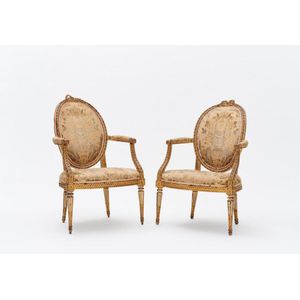Italian Louis XVI Style Fauteuils, 19th Century
A pair of 19th century north Italian Louis XVI style fauteuils, Fourth quarter 18th century, the oval backs surmounted by ribbon bow, with carved foliate arms and guilloche pattern seat rails, on circular tapering reeded legs, upholstered with worn silk velvet, 64 cm wide, 50 cm deep, 96 cm high
You must be a subscriber, and be logged in to view price and dealer details.
Subscribe Now to view actual auction price for this item
When you subscribe, you have the option of setting the currency in which to display prices to $Au, $US, $NZ or Stg.
This item has been sold, and the description, image and price are for reference purposes only.
- Reeding - A series of parallel, raised convex mouldings or bands, in section resembling a series of the letter 'm'. The opposite form of fluting, with which it is sometimes combined. Reeding is commonly found on chair legs, either turned or straight, on the arms and backs of chairs and couches and around table edges in the Neoclassical or Classical Revival manner. Reeding was also used as a form of decoration during the Edwardian period, but it is usually much shallower and evidently machine made.
- Foliate - Decorated with leaves or leaf-like forms.
- Guilloche - A form of classical decoration consisting of a repeating ornament of interlacing curved bands, sometimes forming circles, and further decorated with rosettes or other flower forms.
The name is derived from the inventor, French engineer Guillot, who invented a mechanical method of inscribing fine repeating patterns on to metallic surfaces.
On enamelled items with guilloche decoration, the surface is firstly engraved with the repeating pattern, and then covered with several layers of enamel, each of which is fired.
Where the item has not been enamelled the form of decoration is usually called "engine turned".
This item has been included into following indexes:
-
chairs, singles / pairs / threes, style or period
- fauteuils (arm chairs) 244
- French 962
- Italian 96
- Louis XVI 187
Visually similar items

Modern 8 mm natural white pearl necklace
Sold by
in
for
You can display prices in $Au, $US, $NZ or Stg.

9ct solid opal brooch approx 6.5 grams
Sold by
in
for
You can display prices in $Au, $US, $NZ or Stg.

Sold by
in
for
You can display prices in $Au, $US, $NZ or Stg.

Circular framed print of the Sacred heart of Jesus. Diameter 14 cm
Sold by
in
for
You can display prices in $Au, $US, $NZ or Stg.
